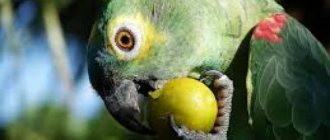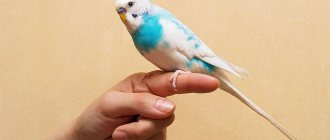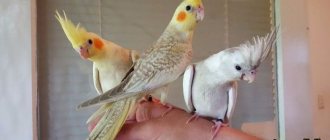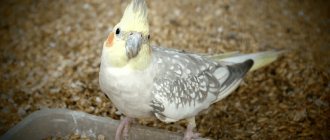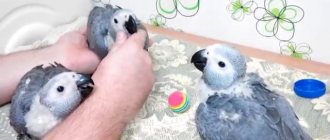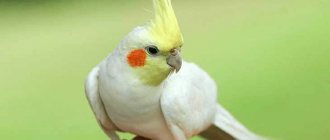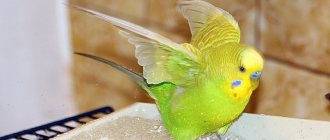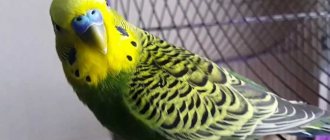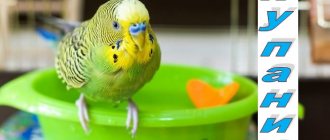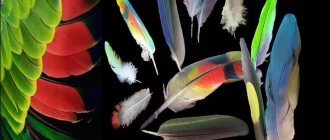Parrots need water treatments, because this is one of the conditions for care, as well as part of a healthy lifestyle. Most often, birds love to swim, but there are finicky individuals who are afraid of water. Today we will talk about how to bathe a tame cockatiel and how to turn washing into fun. Let's look at several ways to keep things clean and take safety precautions while swimming.
How to make washing a habit
If your parrot doesn't feel like bathing at home, you shouldn't force it. The bird is gradually accustomed to rinsing so that he does not have a fear of water. To do this, place the bathing suit in a visible place in the cage; you can do this on a hot day so that the parrot has a desire to freshen up.
If the owner notices that the bird is trying to bathe in the drinking bowl, you can place a bath nearby and unobtrusively invite it to take a dip in a larger vessel. If your parrot has a favorite treat, you can put a piece of the treat in the bath, which will attract the bird's attention. Interest and love for sweets will lead the bird to water, this will be the first step to clean plumage. When it rains, you can open the window slightly so that the bird hears the sound of falling drops, this will also instinctively attract it to the water.
Important! It is permissible to open windows only if there are nets on them, and the pet does not have the slightest chance of flying out into the street.
The sound of tap water has the same effect on your cockatiel as the sound of rain and encourages you to take a bath.
Accustoming a bird to water
In nature, when parrots fly to a watering hole, they sit directly on the water, without risking drinking on the shore, so at the genetic level, the bird should not have a fear of water. Especially considering the fact that wild relatives willingly wash their feathers in dew.
Behavior in captivity can differ sharply from habits in the natural habitat. The cockatiel, or nymph, as it is also called, may not show a desire to rinse itself, and may demonstrate an outright dislike for water. It would be fundamentally wrong to try to bathe a feathered pet against its will. This will not only cause stress, but will also completely destroy the trust between you. As a result, the bird will never want to approach the water at all.
The best option for gradual training is to place a container with a small amount of water in a visible place. Cockatiels are curious, and on a hot day the desire to take a dip or simply wet their feathers is a natural instinct. Another method to get people interested is to leave the tap open so that the water flows under low pressure. This option is suitable for free-living pets with the cage doors open. An interesting method is spraying, but more on that below.
Did you know? The pioneers in breeding parrots were the ancient Indians. Then the Greeks and Romans picked up the baton; according to some reports, the birds were brought home by the soldiers of Alexander the Great as trophies from military campaigns.
Necessity of the procedure
In Australia, where the nymphs come from, there is high air humidity. For birds whose body temperature is above 40 degrees, this is a necessary condition for a healthy life. Housekeeping in our drier climate requires bathing, otherwise the pet's skin will dry out.
Birds need bathing during molting; it relieves itching and facilitates the appearance of new plumage. If the air in the room is very dry during the breeding season, the female and male take turns moistening the eggs with their own damp feathers. This prevents the shell from drying out and maintains optimal conditions for the development of future chicks.
Important! Due to dry skin, various skin diseases may occur and feathers will begin to fall out.
Treatment frequency
To maintain hygiene, it is recommended to bathe the nymph about 2 times a week. Most often, it is recommended to refresh in the heat, which will allow the parrot to tolerate it more easily. In principle, a bath filled with water should always be available, and the owners of the cage will determine the frequency of taking a “bath” themselves. In winter, birds rarely feel the desire to swim, but in a dry room with good heating devices they still resort to ablution.
Different ways of bathing
The easiest way to bathe a cockatiel is to purchase a special bath (bath) for parrots. She should always be in the bird’s field of vision, in his house. You can simply put a plastic container of suitable size. The main thing is that the bird fits in it. Then the bird will happily splash around and clean its feathers in its own impromptu pond.
Spraying
You can train your bird to spray from a spray bottle. Only the mode chosen is spraying, not jet - a directed flow of water can frighten the bird, and all attempts to accustom it to bathing will be in vain.
You can start by misting the flowers or spraying water around the cage. The smoothly falling wet dust will interest your pet, and he will fly closer to feel it on his body. Such water procedures are repeated for several days.
Then you can try to carefully irrigate the bird and monitor its reaction. If your parrot gets scared, you should wait a few days and then try spraying water around your pet again.
If, nevertheless, the bird is afraid of such ablutions, it is worth coming up with another way to bathe the cockatiel parrot.
Splashing under the tap
If your pet cockatiel moves freely around a human home, you can try opening the bathroom faucet in his presence. At the same time, they observe the bird’s reaction: whether it is interested in the murmuring of water and the steady flow of water jets. At this time, the owner needs to monitor the water pressure (it should not be strong) and ensure that detergents do not appear in the feathered pet’s field of vision.
You can cover the sink or bathtub with a towel to prevent your budgie from rolling down. You should exclude this method if the water in your area leaves much to be desired and there are no filters in the water supply system. Harmful contaminants can have a detrimental effect on your pet's health. If this method is not useful, you can come up with another method on how to bathe a cockatiel parrot.
Herbal bath
In their natural habitat, parrots often bathe in dew. You can offer this method of bathing in an apartment. To do this, you should collect a small bouquet of meadow herbs, preferably away from the sides of roads. The grass is brought home and washed thoroughly under running water. While still wet, it is placed in a birdcage. Fresh plants are sprayed with a spray bottle over time. Perhaps your pet cockatiel will enjoy this type of bathing.
Why bathe a bird
The motley pet prefers to lead a neat lifestyle: it cleans its feathers every day, watches its reflection in the mirror, washes itself, smoothes its tail, and straightens stuck feathers. To keep the feathers from getting wet, the bird is ruffled and then shaken. The parrot carries out general bathing with its head on its own. Pets love to dive into a cool, refreshing bath on a hot, sultry day. The purposes of bathing depend on the types of pollution. After all, dry cleaning with a beak does not help if:
- Feathers are contaminated with fruit juice.
- Strongly stuck together under the influence of paint and oil.
- The skin is very itchy.
- The effect of dry air on the bird's body leads to a desire to freshen up.
- The bird wants to play in a small pool.
In the autumn and winter seasons, it is not recommended to bathe birds in order to avoid the development of colds.
How to wash a parrot from vegetable or vaseline oil so as not to mentally and physically injure the bird? You need to purchase Ciamax from a veterinary pharmacy - a drug in powder form that removes toxins from the body. But the point is different, veterinarians recommend sprinkling the powder well on the bird’s body, waiting 15 minutes, then using a toothbrush to clean the fused feathers. Instead of the drug, you can take a pinch of flour or starch and repeat similar steps. The third way is to carefully bathe the bird with a special shampoo for parrots (sold in veterinary pharmacies), and then limit the effect of drafts.
Safety rules when bathing a parrot
It would seem that everyone knows how to wash a bird. It’s a simple matter, but care is required so as not to harm the physical and psychological health of the bird.
How to wash a parrot without causing a storm of indignation - a few simple rules will reveal the secret. Compliance with them will give the parrot and its owner only pleasant emotions when taking water procedures.
- There should be no drafts in the room. While the cockatiel is bathing, all windows are closed.
- The water temperature should be slightly above room temperature, including in the spray bottle when pouring.
- The bird bath must be clean, and household chemicals must not be added to the water - this is harmful to the birds.
- Fill the container with water to a level of no more than 3 cm. In a deep container filled to the brim with water, the parrot may die.
- At home, the cockatiel is bathed before lunch; he should have the opportunity to dry thoroughly before evening.
If the parrot does not dry out at all, you can blot it with a clean towel or dry paper napkins. Do not dry poultry with any electrical appliances. Their noise will frighten the bird, and the hot air will dry out the skin and feathers.
How to determine if your feathered friend likes water treatments
If the owner does everything correctly and knows how to bathe a cockatiel in simple and homely conditions, the bird will gratefully accept this care. She will straighten her feathers, begin to chirp and splash, and expose her breasts to the stream of water. Active movements and raising of the wings also indicate complete peace of the parrot.
It is important to take a closer look at exactly how and in what way the cockatiel parrot likes to bathe most. Whether he splashes under running water or prefers his own bath does not matter. The main thing is that the process of bathing cockatiels pleases both the owner and his feathered pet.
How often
Often, inexperienced bird breeders wonder how often to wash pet cockatiels. Everything is simple here: if the bird likes the process of bathing, then at least every day. The main thing is to observe the temperature regime of room air and water, provide a special bathing suit for the cockatiel and give him the opportunity to splash around in warm water.
It is important to bathe the bird in summer, during hot periods and in winter when heating appliances are running. By taking a bath, the parrot solves the problem of dry skin on its own.
It is necessary to accustom your pet to water procedures in a good mood, with love and patience. The bird at this time should also be healthy, in a good mood, and tuned to contact with the owner. It is not difficult to wash a parrot, especially a cockatiel, the main thing is to know how to do it correctly.
How to tell if your cockatiel likes to swim
The main indicator of interest in water is the behavior of the cockatiel while swimming. If the pet enjoys it, it makes sounds of joy, spins, squats, and puffs up its wings. Hearing noise and splashing water in the bathroom, the parrot tries to get there. Any container with water, be it a pan, a jar or a basin, will be immediately attacked by the feathered fidget.
Bathing only brings benefits to the bird, especially in hot weather, as well as in winter when heating devices are on. Dry air has a bad effect on the condition of mucous membranes, skin and feathers, and moisture brings this situation back to normal. If a cockatiel parrot loves to bathe, he can do it at least every day.
Once you decide how to bathe your cockatiel, one of the care problems will be solved. A parrot that is not afraid of water always remains happy and cheerful, and also looks neat.
